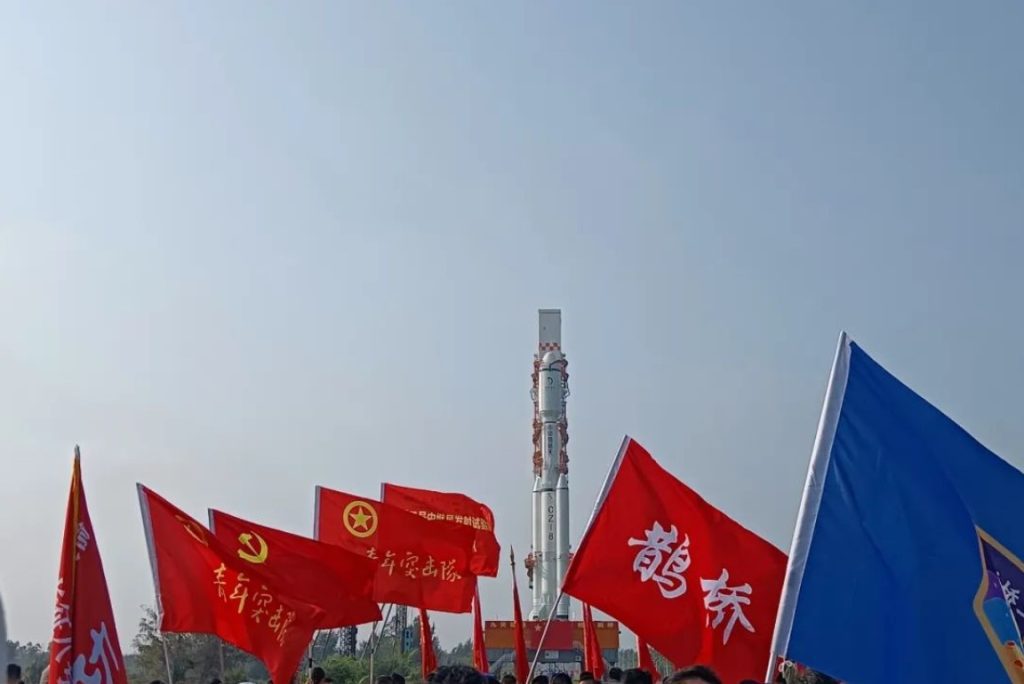HELSINKI — China plans to send its Queqiao-2 satellite into space on March 19 to support future moon missions.
On March 17, a Long March 8 rocket was moved to a launch pad at Wenchang Satellite Launch Center. It will send Queqiao-2 to the moon for the upcoming lunar far side sample return mission in May. Chang’e-6 Queqiao-2, weighing 1,200 kilograms and featuring a 4.2-meter parabolic antenna, will be able to communicate with both Earth and the lunar far side, which never faces the Earth, from its elliptical orbit.
The satellite has a mission lifetime of over eight years and aims to support both Chang’e-6 and future missions to the lunar south pole.
Chinese authorities have not publicly announced the launch time and date, but airspace closure notices reveal two launch windows: 8:21-8:47 p.m. and 9:45-10:16 p.m. Eastern on March 19. Chang’e-7 and Chang’e-8 Queqiao-2 aims to reach a highly elliptical, frozen lunar orbit inclined by 55 degrees and will communicate with both Chang’e spacecraft and Earth using various bands and multiple data rates.
China conducted its first lunar sample return mission in 2020, and Chang’e-6 will attempt to grab up to 2,000 grams of material from the lunar far side, supported by Queqiao-2.
The satellite is an advanced version of the original Queqiao launched in 2018, which is still operational in a halo orbit around the Earth-moon Lagrange point L2.
Queqiao-2 also carries payloads for the science objectives of the 2026 Chang’e-7 mission, including an extreme ultraviolet camera, an array neutral atom imager, and an Earth-moon length baseline very long baseline interferometry (VLBI) experiment.
Additionally, small experimental satellites Tiandu-1 and Tiandu-2 will be part of the launch, flying in formation in lunar orbit and conducting tests for navigation and communications technology verification.
The goal of the Tiandu satellites is to provide information for the development of China’s planned Chang’e-5Queqiao lunar navigation and communication group
Queqiao-2's launch comes after the
probable loss of two satellites Chang’e-4 that were meant to go into a path around the moon called lunar distant retrograde orbit. The DRO-A/B satellites were launched on a Long March 2C rocket from Xichang spaceport. The YZ-1S upper stage of the mission had a malfunction, which is currently believed to have placed the satellites in orbit around the Earth that is close to the surface.
The launch will be only the third one for the 50.3-meter-long Long March 8 rocket. It first flew in 2020, and at that time set a record in the country for the most satellites launched in a single mission in
The Long March 8 uses the 3.35-meter-wide new-generation Long March 7 kerosene-liquid oxygen first stage along with a 3-meter-wide liquid hydrogen-liquid oxygen second stage from the older Long March 3A series. An improved version of the rocket is planned to fly for the first time from a new, commercial launch sitenear Wenchang spaceport in the next few months.
China is scheduled to send its Queqiao-2 communications relay satellite into space to assist upcoming moon missions late on March 19. Queqiao lunar navigation and communication constellation.
The launch of Queqiao-2 follows the apparent loss of a pair of satellites intended to enter lunar distant retrograde orbit. The DRO-A/B satellites launched on a Long March 2C rocket from Xichang spaceport. The mission’s YZ-1S upper stage suffered a malfunction, currently thought to have left the satellites in low Earth orbit.
The launch will be just the third for the 50.3-meter-long Long March 8 rocket. It flew for the first time in 2020, before setting a then-national record for satellites on a single launch in early 2022.
The Long March 8 combines the 3.35-meter-diameter new-generation Long March 7 kerosene-liquid oxygen first stage with a 3-meter-diameter liquid hydrogen-liquid oxygen second stage from the older Long March 3A series. An upgraded version of the rocket is slated to fly for the first time from a new, commercial launch site near Wenchang spaceport in the coming months.









